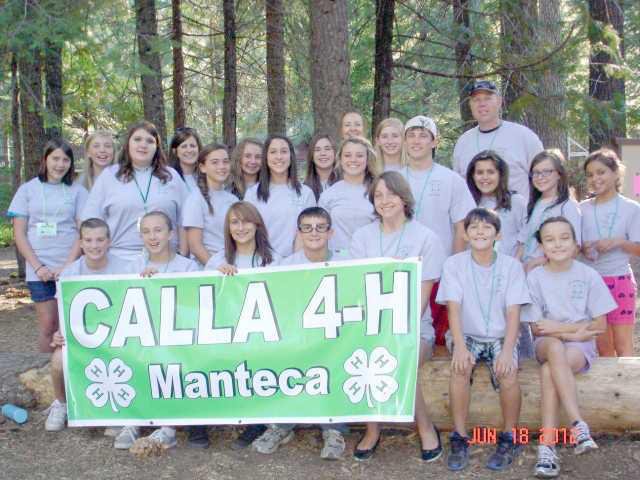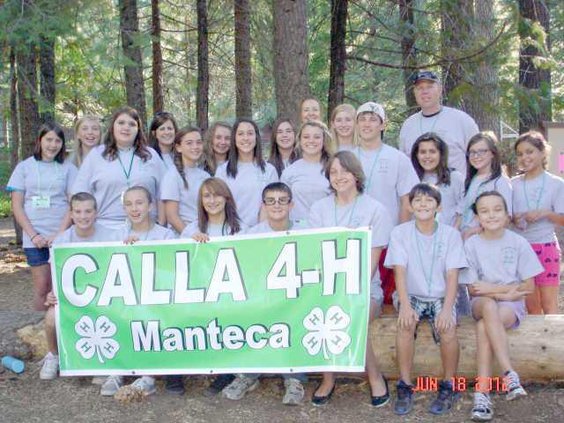Fred Ware grew up in 4-H. So did Sharie. She raised mostly sheep. He did horses, goats and dogs.
They both belonged to Circle M 4-H which sometimes met at Lincoln Elementary School.
Today, there is no more Circle M 4-H. “It disbanded probably about six years after I got out of 4-H,” recalled Sharie.
But Circle M is still very much in the mind of Sharie and Fred. That’s where they met. And today, nearly two decades later of married bliss, all three of their kids ages 10 to 15 are also being raised around 4-H. This time, they belong to Calla 4-H, one of the longest-running groups in this very busy and activity-diverse youth organization.
And while there have been some changes through the years, there are no generation-gap maladies in the Ware household. While 4-H has grown and some changes have been instituted in time, the core of its mission has remained steadfastly the same: preparing and training well-rounded youth for the future and as future leaders of their communities and beyond.
“I think that (4-H) is still going on because it teaches such a good balance of farm and different projects. You can do crafts. You can do sewing, and do all the ag projects. It teaches a wide variety of different things – not just one area – and it reaches a lot of age groups,” said Sharie who owned and operated an independent towing service for many years in Manteca, and one of the leaders of Calla 4-H. Her husband is a truck driver.
“4-H kids are always busy. We’re always keeping them busy. We keep the program busy and the projects interesting so they don’t get into trouble,” Sharie explained.
Calla 4-H offers more than 2 dozen programs
In the Calla 4-H group alone, there are more than two-dozen programs or activities that the young members can get involved in depending on their interests. 4-H groups are perennial fixtures at the annual San Joaquin County Fair, for example, where they show their animals ranging from rabbits and sheep to goats and pigs. They are quite a visual presence at the fair that sometimes people don’t know they have a slew of other activities not related to the business of agriculture as well.
For one thing, “we have food competitions. We make dishes and enter it in the Food Fiesta. They judge the dishes and the children can win an award. Food Fiesta is a county event that happens usually in February. We also have a sewing event. We also have a speech and presentation day where members do speeches and do readings of books,” Sharie further explained, touching only the tip of the iceberg when it comes to the plethora of educational activities that young members can get involved in.
“Those are all things that they can use later in life,” she pointed out.
As far as raising animals and chickens for the county and state fair are concerned, this activity “may open up a window for (4-H members) and may help them decide to become a veterinarian someday because they had the experience (with animals) when they were younger,” she said.
If a member doesn’t have the experience and knowledge to raise the chickens or the animals, 4-H is there to help.
“And they are a lot of fun; they are!” Sharie said with a laugh as she talked about the different animal projects available to the young club members.
The young 4-Hers can earn money through their animal projects, too, when they get their sheep or pigs sold at auction at the fair.
4-H teaches responsibility
But there’s another aspect of these projects that are priceless because one can’t ever put a price tag on it: responsibility.
“Teaching them responsibility is a big part; they have to learn to be responsible to take care of those animals,” Sharie stated.
The children quickly learn the value of responsibility once they realize what happens when their animals go to market. Depending on the animal and the current market for their breeds, after figuring the expenses and factoring them out, some of the children can net $400 each time. Some of them even “bring up to a thousand dollars depending on how big is their animal, and their variety. But that’s today,” Sharie qualified.
“When I was raised in 4-H, the animals were much smaller. I’m the sheep leader, and lambs are twice as big as they used to be. You get more meat out of them. They are breeding for bigger animals,” she explained.
Something else that has been changed since she was a student member of 4-H is the type of animals or birds that club members today can take on as projects.
“Then, they didn’t sell turkeys. Turkeys are new. And they didn’t sell meat goats. Now they do,” she said.
Being an urban dweller in residential subdivisions with zero-lot-lines homes should be no hindrance to raising animals in 4-H either, added Sharie. When she was a young club member, that was her situation. She lived in the city.
But, she said, “I’m lucky enough that my parents lived out in the country, so we were able to keep our animals at their house.”
What happens if a 4-H member who wants to raise animals is not as lucky as she was? “We have a couple of leaders that offer to keep animals at their house,” Sharie said.
Community involvement is very much a part of 4-H as well. McKayla, the oldest of Sharie and Fred’s three children who goes to Venture Academy with the San Joaquin County Office of Education, is involved in the club’s leadership project. McKayla has been in 4-H since age 8. “She really enjoys it,” Sharie said.
Son Caleb, 10, is into raising sheep and is also involved in crafts projects. Youngest Elijah, 7, is still in Clover, the name given to the younger set in 4-H.
Plenty of fun things to do
Both groups – Clover and regular 4-H members – all work together when it comes to their Community Pride program “where you do different projects for the community,” Sharie said.
“They have made crafts on Valentine’s Day and took them to local senior homes. They do that a few times on different occasions. They also did Relay for Life (for American Cancer Society), and will do the one in August in Lathrop. The children raise money by doing the laps.”
There are also plenty of fun things that the members can avail themselves of while learning various skills and life-saving lessons at the same time. Just recently, from June 18 to 21, about two-dozen members of the Calla 4-H club attended the 4-H Camp at Camp Sylvester at Pinecrest Lake. The young campers participated in archery, outdoor cooking, canoeing, hiking, swimming, leather and tile crafts, campfire activities, among many other things, reported 4-H leader Nancy Sanguinetti Franzia, one of the adult chaperones who accompanied the group.
Some of the campers and chaperones went on a two-and-a-half-hour hike around the lake as well.
“I love to see the kids progress from being shy and quiet the first day of camp, to organizing their own skits and performing on stage in front of everyone by the end of camp. They seem to always make camp pals,” Sanguinetti Franzia said.
Anyone interested in 4-H is invited to attend a Calla 4-H Information and Registration Night on Thursday, Aug. 16, held in the New Haven School cafeteria, 14600 S. Austin Road, or contact Shayne Rivers at (510) 303-9038 or Sharie Ware at (209) 629-7181.
MAKING A DIFFERENCE
Keeping 4-H relevant in the age of high-tech





